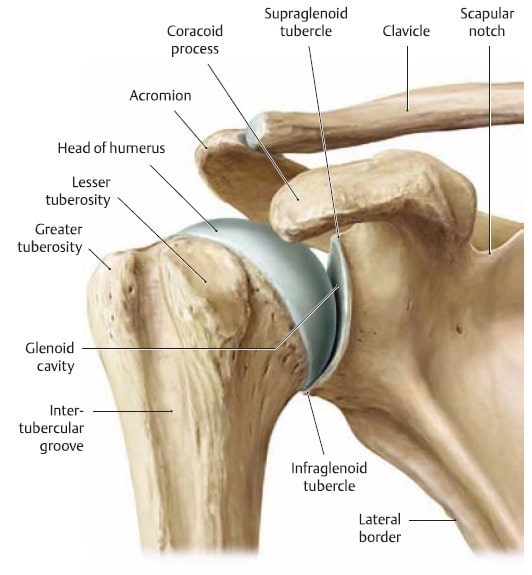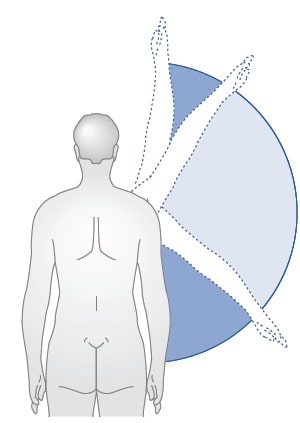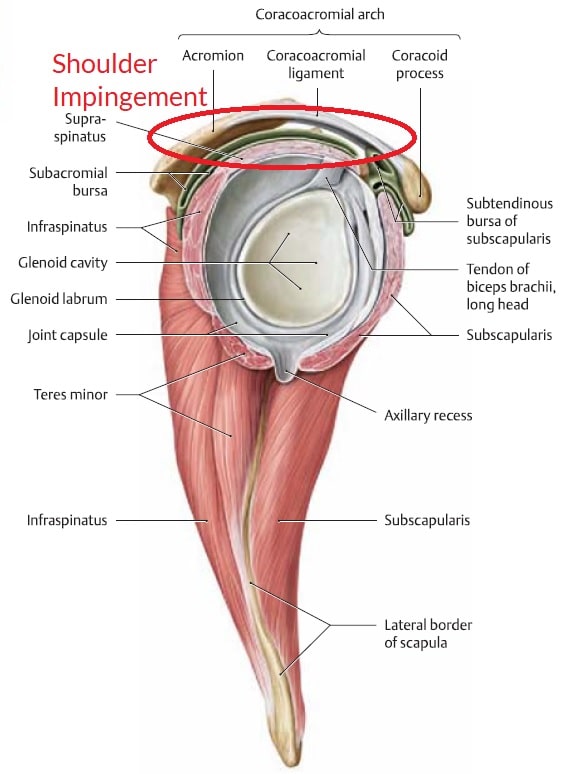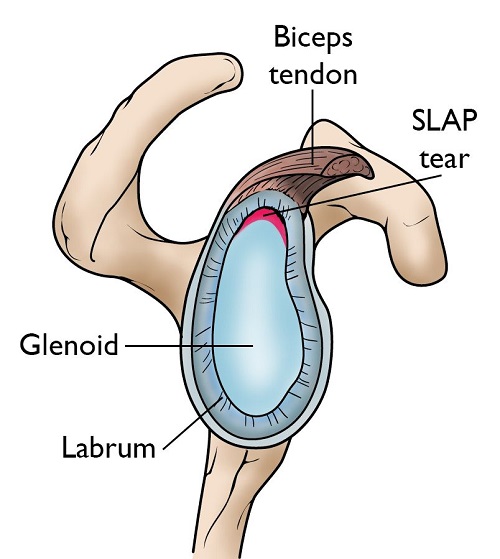Shoulder impingement and shoulder instability are common climbing injuries. But what are the differences between them?
Here’s a quick overview.
Shoulder impingement is mostly an overuse injury and in rare cases traumatic. Shoulder instability on the other hand is more often a traumatic injury. Then, shoulder impingement can have an underlying inflammatory process and is well treated with manual therapy and exercises. When it comes to recovery times, healing shoulder instability takes 6 months but shoulder impingement can be cured in 3 months.
That was the short and simple answer.
Do you want to understand what shoulder impingement is though? And discover the 3 types of shoulder instability?
Then I recommend you keep on reading.
Even more so, because besides explaining shoulder impingement (and why it should be called differently) and shoulder instability I will also be discussing a whopping 11 differences between the two.
Thus, after reading this blog you’ll have an excellent overview of the two injuries and how you can tell them apart. This will help you in making educated decisions on your recovery and hopefully prevent it from ever limiting your climbing again!
1. What is Shoulder Impingement?
Shoulder impingement is the entrapment of structures on top of your shoulder joint underneath your acromion. This is the part of your shoulder blade above the upper arm where it connects to your collar bone.

The first person to come up with the condition was Dr. Charles Neer, a surgeon who in the 1970s found that the impingement of subacromial (below the acromion) structures was prone to friction at certain positions of the shoulder joint. He then went on to argue that this was the cause of the pain his patients were experiencing.
Nowadays, there’s still a special orthopedic shoulder test called “Neer’s Test” which is used to test for shoulder impingement.
We have come to understand shoulder impingement as a condition that causes pain, discomfort and might or might not reduce the ability to raise your arm. If you find it hard to raise your arm, this usually happens between 60- and 120-degrees abduction. That range of motion is called a “painful arc”.

Typically, you feel shoulder impingement-related pain at the top or front of your shoulder. With or without the pain radiating into your upper arm.
This is the “common understanding” of shoulder impingement.
However, this concept is flawed.
1.1 What Impinges in the Shoulder?
Before I go on to show you exactly how the concept of shoulder impingement is flawed, I think it’s useful to know which structures impinge in the shoulder.
Structures that often impinge between the acromion and the Humerus (upper arm) are:
- Tendon of the long head of the biceps
- Tendon of the supraspinatus
- Subacromial Bursae

Which structure is impinged is to be confirmed by using special tests to provoke your pain or by doing an MRI. Furthermore, some researchers believe that people with certain shapes of acromion have a higher chance of shoulder impingement.1

Now, I’ll show you why the concept of shoulder impingement is wrong.
1.2 The Problem with Shoulder Impingement
The first and foremost reason that shoulder impingement isn’t provoking your shoulder pain is that impingement happens both in people experiencing shoulder pain, as well as in healthy individuals.2
What does this mean exactly?
There is often some form of shoulder impingement when you move your arm up and down. Regardless of you having shoulder pain or not.
Secondly, shoulder impingement is often diagnosed by using special orthopedic tests which are meant to provoke your pain. However, all of the special tests of the shoulder are unreliable.3
And then finally, Magnetic Resonance Imaging (MRI). Positive findings on an MRI have always been thought of as the “gold standard” in science when it comes to diagnosing orthopedic injuries.
What is a gold standard?
Imagine you have a new measurement for distance in which, the gold standard would be the metric or the incremental system. These measurement systems are proven to be reliable and can be reproduced. For the sake of this argument, let’s take the metric system.
Let’s say the distance from your house to the nearest bus stop is 2 kilometers. Now you use your new measurement system and find that it’s 1.2 “paces”. If you then walk to the next bus stop, which coincidentally is 2 kilometers from the current one, you find that your new measurement system shows you it’s 0.8 paces. That doesn’t add up, does it?
With the gold standard of the metric system, you can now say that your new measurement system is unreliable.
Now imagine.
That the metric system is unreliable itself but is still used as a gold standard.
That would get messy, wouldn’t it?
And that’s exactly what happens when comparing the pain you experience with orthopedic special tests and MRIs.
As things go, when you see something on an MRI it doesn’t have to be the reason for your pain.4
Because pain is much more complicated than being the equivalent of structural damage.
Pain is worth a million blog posts, but for the sake of this argument here’s a quick overview of factors that influence pain:
- Mood
- Stress
- Previous Injuries
- Overuse
- Underuse
- Sleep
- Diet
- Fitness level
- Culture
And on top of that, an MRI is a static image whereas your body always moves.
1.3 Shoulder Impingement as an Injury
Does this mean that shoulder impingement isn’t a clinical condition at all?
Yes.
Yet, there’s a little “but” here.
Of course, shoulder impingement can cause pain if it happens with high force. Imagine falling on your arm or catching a heavy fall with one arm. This can damage structures in the subacromial space.
These injuries, though, are diagnosed as tendon tears, labral tears, muscle strains, or whatever other damage it provoked.
1.4 A better Name for Shoulder Impingement
Since I understood how the concept of shoulder impingement is flawed, I decided from then on to use the more general term: “shoulder pain”. Whereafter, I won’t tell you that structures are being trapped in your shoulder.
But that your shoulder is sensitive. This covers better the reality of shoulder pain and is also easy to explain. You need to desensitize your shoulder by normalizing movement, strengthening the shoulders, and reduce factors that increase pain.
For the remainder of this article, I’ll use the terms “shoulder impingement” and “sensitive shoulder” interchangeably.
So, now you know the truth about shoulder impingement.
Let’s continue with discussing shoulder instability.
2 What is Shoulder Instability?
First off, don’t worry. Unlike shoulder impingement, shoulder instability is as it sounds: instability of the shoulder joint.
Shoulder instability comes in many forms, so I’ll these discuss first.
2.1 3 Types of Shoulder Instability
According to the Stanmore Classification of Shoulder Instability, you can classify shoulder instability in 3 categories5:
- Type 1: Structural Instability. This type of instability is due to traumas like subluxation of the shoulder joint, a labrum tear, or a rotator cuff muscle tear.
- Type 2: Atraumatic Instability. With this type of shoulder instability, there is no trauma but often both shoulders are unstable. This can cause recurring shoulder subluxation and discomfort during regular and sporting activities. The origin of this instability varies and can be due to congenital alterations in the shoulder joint, anterior capsule laxity, and/or posterior capsule tightness.
- Type 3: Neurological dysfunctional or muscle patterning problems. In this case, there’s no trauma and nothing structural causing instability. The instability comes from the fact that certain muscles fire when others should. For example, the latissimus dorsi (the big back muscles or the “lats”) might take over the role of the rotator cuff muscles.
2.2 Symptoms of Shoulder Instability
Shoulder instability can provoke pain and discomfort. It can also change the motion of your shoulder joint.
You might experience:
- A sense of weakness
- Discomfort holding onto holds that require (excessive) shoulder rotation
- Lack of coordination, a sense of not having proper movement control in certain positions
And on top of that, a lack of mobility. This sounds counterintuitive, but it’s not uncommon that your body compensates for limited stability by reducing the range you can move your shoulder through. This way, you won’t be able to get into “weak” positions.
3. The 11 Differences between Shoulder Instability and Shoulder Impingement
3.1 Shoulder Instability can be Congenital
If you have atraumatic shoulder instability (type 2), you might’ve been born with this. This is never the case with shoulder impingement.
3.2 Shoulder Impingement is due to Overuse
Shoulder impingement is always due to some type of overload. Typical origins of overuse are:
- Not allowing enough time to recover between climbing sessions
- Spending too much time sitting in a flexed position
- Increasing your climbing intensity overnight (instead of building it up in small steps)
- Climbing with poor technique
- Climbing with postural faults
- Climbing with reduced thoracic mobility
Shoulder instability on the other hand has many ways of coming on, but overload is seldom one of them. The only time you could argue shoulder instability is due to overuse is when you tear a muscle or tendon due to chronic overload, which then leads to type 1 shoulder instability.
3.3 Shoulder Instability Takes Longer to Heal than Shoulder Impingement
Isolated shoulder instability takes 6 months to a year to train away. It’s therefore recommended to build your coordination, stability, and strength progressively over time. All the while pushing your shoulder into new positions to become stable in these.
As a climber, you want to do this well because most of your climbing consists of overhead movements. The area your shoulder is most unstable at.
Shoulder impingement or sensitive shoulder, on the contrary, can be treated effectively within a timeframe of 3-4 months. There are quite some factors that influence healing times. For example:
- Reduced thoracic mobility
- Altered scapular kinematics
- Muscle imbalances
- Shoulder instability (more on that in a bit)
- Capsular restrictions
- Training load
- Sleep quality
- Stress levels
- Fear-avoidance/ignorance (shying away from the pain or pushing through it)
3.4 The Ways in which the Healing of Shoulder Impingement and Shoulder Instability Progress Differs
A sensitive shoulder, with the help of manual therapy and exercises, often starts to improve quickly. Whereafter, the progress slows down. Usually, then a solid training plan will help you fully recover within 2 to 3 months.
Shoulder instability, on the other hand, heals slowly in the beginning. Then, as soon as your shoulder gets stronger you can increase the intensity of your exercises. Which in turn helps you progress faster.
3.5 Manual Therapy is More Effective for Shoulder Impingement Than for Shoulder Instability
As I wrote above, a sensitive shoulder is heavily influenced by the mobility and stability of surrounding joints. Mostly the thoracic spine and the scapulothoracic joint. If you improve these with manual therapy, your shoulder pain often reduces right away.
If you do the same when you have shoulder instability it might alleviate discomfort, but it doesn’t otherwise change anything about the strength of your ligaments and rotator cuff (the muscles responsible for stabilizing your shoulder joint).
3.6 Shoulder Instability Doesn’t Need to Provoke Pain
Since shoulder instability says something about the strength of your shoulder, there’s a chance you won’t experience pain. Discomfort is common in certain positions, but only in rare cases, people can dislocate their shoulders without hurting themselves.
If your shoulder is sensitive though, you’ll always experience some type of pain.
3.7 Differences in Epidemiology
In rock climbing, shoulder impingement is a common injury. Even though it doesn’t occur as often as finger injuries, a study that was done by German researchers found that shoulder impingement did make up 5.4% of the injuries.6 Bear in mind though, what I explained at the beginning of this article. Shoulder impingement isn’t the right term to be used and thus the number of people suffering from it might differ from what the scientific literature says.
Furthermore, a sensitive shoulder is more often seen in people over 50 years old due to natural degenerative processes and to the fact that tendons become stiffer as you age.
The German researchers also found that SLAP-lesions occurred more often than shoulder impingement. SLAP means Superior Labrum Anterior Posterior which is a tear on the upper part of your labrum which runs from the front to back. Since the labrum is essential in providing shoulder stability, an injury there will lead to angle-dependent shoulder instability. In this case, since the tear is at the top of you labrum, the place you’d feel unstable would be overhead.

Otherwise, traumatic anterior shoulder instability (type 1) happens more often in young males7 whereas generalized a-traumatic (type 2) shoulder instability seems to be found more often in women. This could be due to hormonal differences which lead to joint laxity.8
3.8 Shoulder Impingement Can Have an Underlying Inflammation
An underlying inflammation of the supraspinatus tendon or the subacromial bursa might be what keeps your shoulder sensitive. This is contrary to shoulder instability, where inflammation never is the origin of your instability.
3.9 Your Sensitive Shoulder Might be Cured with Anti-Inflammatory Drugs
If your shoulder is sensitive due to an underlying inflammatory process, like the ones I mentioned above, you might be able to reduce your symptoms by taking anti-inflammatory medication. I believe this should always be part of a cohesive treatment plan which includes manual therapy and exercise therapy to make your shoulder resilient and prevent shoulder pain in the future.
Obviously, anti-inflammatory drugs are something to consult your doctor about.
3.10 Stability Exercises Help to Reduce the Discomfort Your Experience Due to Shoulder Instability
This sounds obvious, right? Stability exercises help against shoulder instability.
But did you know that sometimes you have to push yourself through the initial discomfort of doing these exercises?
It often occurs that pushing your unstable shoulder into positions it doesn’t like causes discomfort and pain. When you keep on practicing though, you’ll notice your will start to feel better and stronger.
This happens to almost all my patients who suffer from shoulder instability. From the beginning of rehab, until the end. That’s why, if your shoulder is unstable, and you can still climb, make sure to add shoulder stability exercises to your climbing warming-up. This will help you feel better and stronger when you climb.
3.11 With Severe Acute Shoulder Instability, Surgery (Followed by Intensive Rehab) Might be Your Best Option
If you dislocated or subluxated your shoulder and one or more tendons or muscles are torn, surgery might be a way to restore your shoulder. Take into account here which structures are injured. If you only have a labral tear you might be ok without surgery. Did you tear one or more rotator cuff tendons though? Then it might be a good idea to fix these in surgery. Obviously taking into account your climbing goals, age, and injury history.
Shoulder impingement on the contrary, in most cases, doesn’t require surgery.
4. Having both Shoulder Instability and Shoulder Impingement
Even though there are distinct differences between shoulder instability and shoulder impingement (sensitive shoulder), they can co-exist.
What does this mean?
That your shoulder instability played a significant role in developing a sensitive shoulder.
Is that your case?
Then be sure to take your rehab process a bit slower. As things go, you have to increase the strength of your shoulder before the sensitivity can go away.
Thus, it’s really important to figure out why you have a sensitive shoulder in order to treat it effectively.
5. Important Take-Aways
Shoulder instability and sensitive shoulder are both conditions of the shoulder. Even though there are distinct differences between the two conditions they can co-exist and/or influence each other.
Where a sensitive shoulder will always provoke some form of discomfort, you might be living with shoulder instability unknowingly.
For effective treatment of both conditions be sure to reduce your training load. Train less intense by climbing below your grade and choose holds that are easy on the shoulder. Once you train on a level that doesn’t provoke discomfort, stay there for 2-4 weeks. If you still experience pain or discomfort, take a couple of weeks off and work on your weaknesses. After this period of (relative) rest start increasing your climbing intensity while increasing the difficulty of your rehab exercises as well. Focus on technique, proper climbing posture, and scapular positioning. This way you work on your weaknesses during climbing as well.
Organizing your training this way, your shoulder tissues can first recover and then adapt better to the progressive load you’re exposing them to. Do this right, and you’ll be able to heal your shoulder injury while you continue climbing.
Since load management can be tricky and is a major part of my job so don’t hesitate to reach out if you have any questions.
6. Citations
- Nyffeler RW, Meyer DC. Acromion and glenoid shape: Why are they important predictive factors for the future of our shoulders? EFORT open Rev. 2017;2(5):141-150. doi:10.1302/2058-5241.2.160076
- Daghir AA, Sookur PA, Shah S, Watson M. Dynamic ultrasound of the subacromial-subdeltoid bursa in patients with shoulder impingement: A comparison with normal volunteers. Skeletal Radiol. 2012;41(9):1047-1053. doi:10.1007/s00256-011-1295-z
- Salamh P, Lewis J. It Is Time to Put Special Tests for Rotator Cuff-Related Shoulder Pain out to Pasture. J Orthop Sports Phys Ther. 2020;50(5):222-225. doi:10.2519/jospt.2020.0606
- Morin SHX, Cobbold JFL, Lim AKP, et al. Incidental findings in healthy control research subjects using whole-body MRI. Eur J Radiol. 2009;72(3):529-533. doi:10.1016/j.ejrad.2008.08.006
- Jaggi A, Alexander S. Rehabilitation for Shoulder Instability – Current Approaches. Open Orthop J. 2017;11(1):957-971. doi:10.2174/1874325001711010957
- Schöffl V, Simon M, Lutter C. Finger and shoulder injuries in rock climbing. Orthopade. 2019;48(12):1005-1012. doi:10.1007/s00132-019-03825-3
- Galvin JW, Ernat JJ, Waterman BR, Stadecker MJ, Parada SA. The Epidemiology and Natural History of Anterior Shoulder Instability. Curr Rev Musculoskelet Med. 2017;10(4):411-424. doi:10.1007/s12178-017-9432-5
- DeFroda SF, Donnelly JC, Mulcahey MK, Perez L, Owens BD. Shoulder instability in women compared with men epidemiology, pathophysiology, and special considerations. JBJS Rev. 2019;7(9):1-6. doi:10.2106/JBJS.RVW.19.00007
